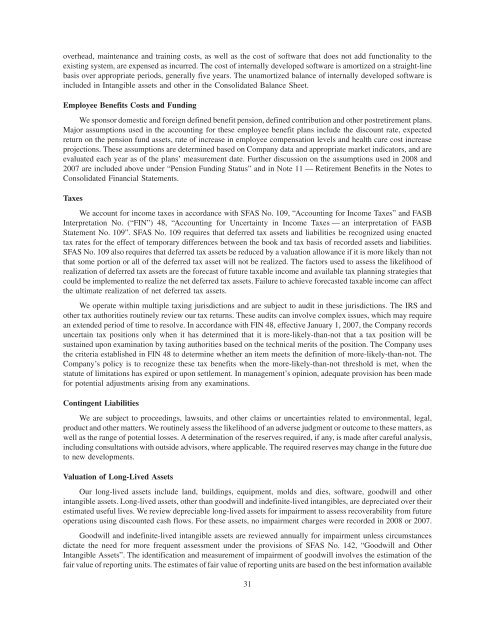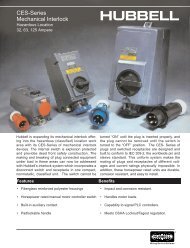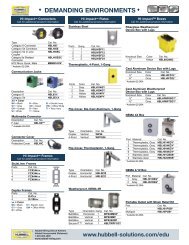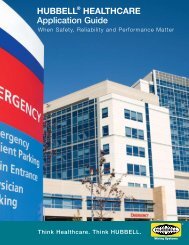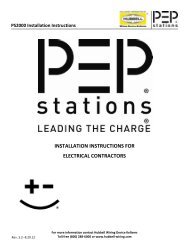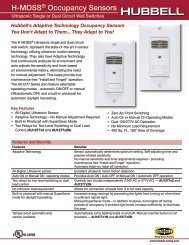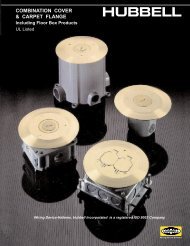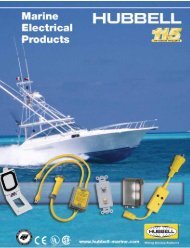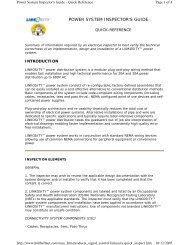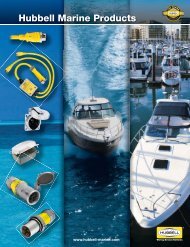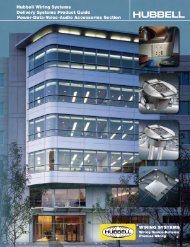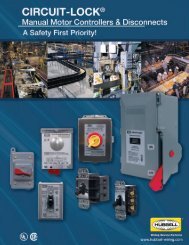2008 Annual Report - Hubbell Wiring Device-Kellems
2008 Annual Report - Hubbell Wiring Device-Kellems
2008 Annual Report - Hubbell Wiring Device-Kellems
- No tags were found...
You also want an ePaper? Increase the reach of your titles
YUMPU automatically turns print PDFs into web optimized ePapers that Google loves.
overhead, maintenance and training costs, as well as the cost of software that does not add functionality to theexisting system, are expensed as incurred. The cost of internally developed software is amortized on a straight-linebasis over appropriate periods, generally five years. The unamortized balance of internally developed software isincluded in Intangible assets and other in the Consolidated Balance Sheet.Employee Benefits Costs and FundingWe sponsor domestic and foreign defined benefit pension, defined contribution and other postretirement plans.Major assumptions used in the accounting for these employee benefit plans include the discount rate, expectedreturn on the pension fund assets, rate of increase in employee compensation levels and health care cost increaseprojections. These assumptions are determined based on Company data and appropriate market indicators, and areevaluated each year as of the plans’ measurement date. Further discussion on the assumptions used in <strong>2008</strong> and2007 are included above under “Pension Funding Status” and in Note 11 — Retirement Benefits in the Notes toConsolidated Financial Statements.TaxesWe account for income taxes in accordance with SFAS No. 109, “Accounting for Income Taxes” and FASBInterpretation No. (“FIN”) 48, “Accounting for Uncertainty in Income Taxes — an interpretation of FASBStatement No. 109”. SFAS No. 109 requires that deferred tax assets and liabilities be recognized using enactedtax rates for the effect of temporary differences between the book and tax basis of recorded assets and liabilities.SFAS No. 109 also requires that deferred tax assets be reduced by a valuation allowance if it is more likely than notthat some portion or all of the deferred tax asset will not be realized. The factors used to assess the likelihood ofrealization of deferred tax assets are the forecast of future taxable income and available tax planning strategies thatcould be implemented to realize the net deferred tax assets. Failure to achieve forecasted taxable income can affectthe ultimate realization of net deferred tax assets.We operate within multiple taxing jurisdictions and are subject to audit in these jurisdictions. The IRS andother tax authorities routinely review our tax returns. These audits can involve complex issues, which may requirean extended period of time to resolve. In accordance with FIN 48, effective January 1, 2007, the Company recordsuncertain tax positions only when it has determined that it is more-likely-than-not that a tax position will besustained upon examination by taxing authorities based on the technical merits of the position. The Company usesthe criteria established in FIN 48 to determine whether an item meets the definition of more-likely-than-not. TheCompany’s policy is to recognize these tax benefits when the more-likely-than-not threshold is met, when thestatute of limitations has expired or upon settlement. In management’s opinion, adequate provision has been madefor potential adjustments arising from any examinations.Contingent LiabilitiesWe are subject to proceedings, lawsuits, and other claims or uncertainties related to environmental, legal,product and other matters. We routinely assess the likelihood of an adverse judgment or outcome to these matters, aswell as the range of potential losses. A determination of the reserves required, if any, is made after careful analysis,including consultations with outside advisors, where applicable. The required reserves may change in the future dueto new developments.Valuation of Long-Lived AssetsOur long-lived assets include land, buildings, equipment, molds and dies, software, goodwill and otherintangible assets. Long-lived assets, other than goodwill and indefinite-lived intangibles, are depreciated over theirestimated useful lives. We review depreciable long-lived assets for impairment to assess recoverability from futureoperations using discounted cash flows. For these assets, no impairment charges were recorded in <strong>2008</strong> or 2007.Goodwill and indefinite-lived intangible assets are reviewed annually for impairment unless circumstancesdictate the need for more frequent assessment under the provisions of SFAS No. 142, “Goodwill and OtherIntangible Assets”. The identification and measurement of impairment of goodwill involves the estimation of thefair value of reporting units. The estimates of fair value of reporting units are based on the best information available31


